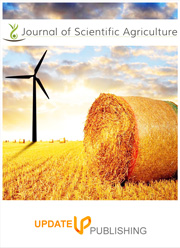The Dominance of physico-morphic plant traits in regulating population density of Bemisia tabaci and Thrips tabaci in Bt and non-Bt Cotton
DOI:
https://doi.org/10.25081/jsa.2019.v3.5308Keywords:
Bemisia tabaci, Thrips tabaci, climatic factors, physico-morphic charactersAbstract
Policy makers, journalists and other commentators often advocate transgenic cotton (Gossypium spp.) as poor-performer against sucking insects that pose a great threat to production targets. A field study was carried out for seasonal occurrence of whitefly (Bemisia tabaci Gennadius) and thrips (Thrips tabaci Lindeman) on two of cotton genotypes namely Bt MNH-992 and non-Bt Cyto-124 under climatic conditions of Multan, Pakistan from July-October, 2017. Impact of environment as a factor was hypothesized on pests on two experimental sites [Research Area (RA) & Farmer Field (FF)]. Maximum population of whitefly at RA (13.5 and 16.7 individuals per plant) for Bt and non-Bt, respectively was recorded during SMW 40, while correspondent minimum populations (0.6 & 1.2 individuals per plant) was found during SMW28 in RA. The peak population of thrips was observed at RA during 30th SMW as (4.9 & 8.9 individuals per plant), respectively at Bt and non-Bt genotypes, declined to the lowest level of (0.1 & 0.3 individuals) in 41st SMW for both genotypes. Bt-cotton harbored relatively lower population of B. tabaci and T. tabaci in both fields owning to the presence of physico-morphich plant characters. A negative correlation of B. tabaci population was found with a maximum temperature and rainfall, and a positive relation with humidity. T. tabaci had a positive correlation with temperature and rainfall, and a negative correlation with relative humidity. The current research concluded that weather factors play and important role to increase or decrease the populations of sucking insect pests of cotton.
Downloads
References
2. Riaz M, Farooq J, Sakhawat G, Mahmood A, Sadiq MA, Yaseen M. Genotypic variability for root/shoot parameters under water stress in some advanced lines of cotton (Gossypium hirsutum L.). Genetics and Molecular Research, 2013;12(1):552-61.
3. Farooq MA, Ali S, Hameed A, Ishaque W, Mahmood K, Iqbal Z. Alleviation of cadmium toxicity by silicon is related to elevated photosynthesis, antioxidant enzymes; suppressed cadmium uptake and oxidative stress in cotton. Ecotoxicol. Environ. Safety, 2013;96:242-249. doi: 10.1016/j.ecoenv.2013.07.006.
4. Sangle PM, Satpute SB, Khan FS, Rode NS. Impact of Climate Change on Insects. Trends in Biosciences, 2015;8(14):3579-3582.
5. Business Recorder. Revised cotton production target missed. 2018. Available at url: https://fp.brecorder.com/2018/02/20180227347413.
6. Gahukar RT. Improving the conservation and effectiveness of arthropod parasitoids for cotton pest management. Outlook on Agriculture, 2006;35(1):41-49.
7. Jose J, Usha R. Bhendi yellow vein mosaic disease in India is caused by association of a DNA beta satellite with a begomo virus. Virology, 2003;305(2):310-317.
8. Malik AK, Mansoor S, Saeed NA, Asad S, Zafar Y, Stanely J, Markham P. Development of CLCV resistance cotton varieties through genetic engineering. A monograph published by Director of Agricultural Information, Punjab, Pakistan, 1995:3.
9. Horowitz AR. Population dynamics of Bemisia tabaci (Gennadius): with special emphasis on cotton fields. Agriculture, Ecosystems & Environment, 1986;17(1-2):37-47.
10. Soni R, Dhakad NK. Seasonal dynamics of Thrips tabaci (Lindemann) and their correlation with weather parameters on transgenic Bt cotton. International Journal of Advanced Research, 2016;4(8):1486-1488.
11. Naranjo SE, Flint HM. Spatial distribution of adult Bemista tabaci (Homoptera: Aleyrodidae) in cotton, and development and validation of fixed-precision sampling plans for estimating population density. Environmental Entomology, 1995;24: 261-270.
12. Analytical Software. Statistix version 8.1: User’s manual. Analytical Software. 2005.
13. Sagar D. Studies on insecticide resistance in leafhopper, Amrasca biguttula biguttula (Ishida) in Bt cotton. (Doctoral dissertation). Department of agricultural entomology, College of agriculture, Dharwad, University of agricultural sciences, Dharwad – 2013;580 005.
14. Jenkins JN. Host Plant resistance to insect in cotton. In: C.A. Constable and N.W. Forrester (Eds.). Challenging the future, World Cotton Research Conference, 1995;1:359-372.
15. Raza ABM, Afzal M, Manzoor T. Physico-morphic plant characters in relation to resistance in some new cotton genotypes against sucking insect pests. Pakistan, NARC, Islamabad 1999;99-100.
16. Jeyakumar P, Tanwar RK, Chand M, Singh A, Monga D, Bambawale OM. Performance of Bt cotton against sucking pests. Journal of Biopesticides, 2008;1:223-225.
17. Bale JS, Masters GJ, Hodkinson ID, Awmack C, Bezemer TM, Brown VK, Butterfield J, Buse A, Coulson JC, Farrar J, Good JEG, Harrington R, Hartley S, Jones TH, Lindroth RL, Press MC, Symrnioudis I, Watt AD, Whittaker JB. Herbivory in global climate change research: direct effects of rising temperature on insect herbivores. Global Change Biology, 2002;8:1-16.
18. Rote NB, Puri N. Population dynamics of whitefly, Bemisia tabaci on cotton and its relationship with weather parameters. Journal of Cotton Research, 1991;5:181-189.
19. Indirakumar K, Devi M, Loganthan R. (2016). Seasonal incidence and effect of abiotic factors on population dynamics of major insect pest on brinjal crop. International Journal of Plant Protection, 2016;9(1):142-145.



 .
.